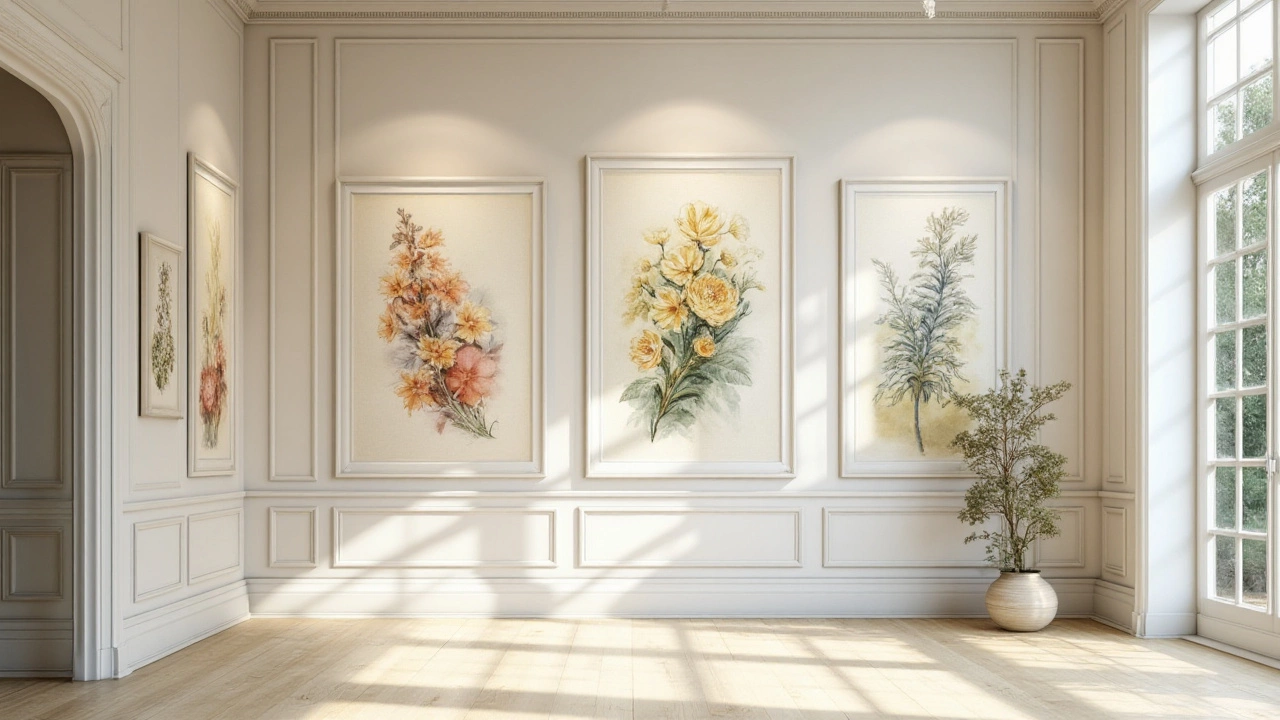When it comes to selling artwork, particularly watercolor paintings, the dimensions of a piece can play a crucial role in its market appeal. Understanding what sizes resonate most with buyers is pivotal for artists seeking success. Not only does the size affect the visual impact, but it also influences how a piece fits into potential buyers' spaces and budgets.
In this article, we'll delve into the significance of size and uncover which dimensions tend to sell best. Whether you're an artist looking to optimize your sales or a buyer curious about art trends, these insights will guide you through the fascinating nuances of watercolor painting sizes.
- The Importance of Size in Art Sales
- Popular Watercolor Painting Sizes
- Impact of Size on Perceived Value
- Display and Practicality
- Artist Considerations and Strategies
- Market Trends and Buyer Preferences
The Importance of Size in Art Sales
The dimensions of a painting aren't just about the physical space it occupies; they tell a story and define a context that can dramatically influence buyer decision-making. From expansive murals that transform entire rooms, to intimate pieces that provide subtle personal narratives, the size of a watercolor painting frequently dictates its suitability for different environments. Buyers shopping for art often have specific spaces in mind, be it a cozy living room or a bustling office. Larger paintings can dominate walls in open spaces, becoming focal points that command attention. Conversely, smaller artworks can fill those untouched nooks, adding character without overwhelming a setting.
It's essential to understand that size can also convey perceived value. Many art enthusiasts associate larger pieces with greater value, drawing parallels between size and the effort involved in creating such work. This perception isn't entirely misplaced. Larger paintings often require more planning and material, potentially justifying a steep price. However, the allure of small, delicate watercolors should not be underestimated. They offer a level of detail and intimacy that large pieces may not capture as effectively.
Besides aesthetic considerations, practical factors come into play. For collectors with limited wall space, compact paintings can offer the joy of ownership without the stress of rearranging or downsizing existing decor. For those uncertain about the art they like, smaller pieces can be a low-risk entry point into collecting, encouraging experimentation and discovery. As stated by renowned art critic Jerry Saltz,
"The best art is not what amounts to a big bang, but what whispers, what seeps into your bones and breathes life into your soul."His words echo the magic that even the smallest watercolor artworks can hold. The importance of size in art sales is intertwined with these subtle nuances, shaping the art market one purchase at a time.
Popular Watercolor Painting Sizes
When diving into the market dynamics of watercolor art, understanding the popular dimensions is incredibly important for artists aiming to capture the interest of buyers. One notable trend is the preference for medium-sized watercolors, typically in the range of 11x14 inches to 16x20 inches. These medium formats strike a balance that appeals to a broad audience. Buyers often find these sizes ideal because they offer enough surface area for artists to work their magic while also being versatile enough to fit different spaces, from cozy living rooms to professional office settings.
Small-sized watercolors, such as those under 8x10 inches, also have their niche. They're particularly appealing to those with limited display space or to collectors looking for more affordable options. These smaller pieces often carry sentimental value, making them perfect gifts. They can be easily grouped to create an engaging gallery wall effect, which is a popular interior design trend in recent years. On the other hand, large watercolor paintings beyond the 18x24 inch threshold bring a commanding presence, often transforming a space and becoming the focal point in a room. These works are typically favored by experienced collectors or patrons looking to make a bold statement.
Size not only impacts aesthetic appeal but also affects pricing and production costs. Medium-sized works, due to their balance in dimensions, usually sell for prices that are attractive both to emerging artists and potential buyers who aren't ready to invest in larger, more costly pieces. This makes them a sweet spot in the art market, encouraging both sales volume and accessibility. For artists, creating at a medium scale can be less resource-intensive but still allow for detailed expression.
Althea once said with a twinkle in her eye, "In the world of art, size communicates as much as color or form." This encapsulates the essence of why size is such a determinant factor.
Buyers are also increasingly interested in tailored pieces. Custom watercolor paintings are becoming popular with commissions for specific sizes that fit modern interiors captivating collectors. This flexible approach allows artists to connect more personally with clients, crafting pieces that are both creatively satisfying and commercially rewarding. Additionally, the convenience of shipping and framing standardized sizes like 11x14 or 16x20 plays a role in their popularity. These paintings often come with pre-made frames or mats, simplifying the purchasing process for buyers who may not want the hassle of custom framing solutions.
Of course, market trends fluctuate, but the trends mentioned above have remained relatively stable due to their practicality and visual impact. Whether an aspiring artist or an experienced professional deciding on the optimal canvas dimensions, the insights into popular watercolor painting sizes offer a foundation for making informed, strategic choices moving forward. Knowing what dimensions attract buyers doesn't only facilitate sales; it energizes artists to create with the confidence that their work will resonate with art lovers and collectors around the world.
Impact of Size on Perceived Value
In the intricate world of art, size holds a significant position in shaping the perceived value of a piece. The dimensions of a watercolor painting can communicate everything from the artist's intent to the story the artwork wishes to convey. For collectors and casual buyers alike, size isn't just about dimensions—it speaks to the investment, be it financial or emotional, that accompanies the acquisition of the artwork. Larger pieces tend to dominate spaces, often becoming the focal point in a room. Their presence can signify grand statements or evoke bold emotions, leaving an indelible impression on viewers. Buyers might associate larger art with higher value, assuming more time, effort, and material costs were involved. This isn't always the case, but perceptions often sway decisions. Meanwhile, smaller pieces offer intimacy, drawing viewers closer for a detailed, personal experience. They're also versatile, fitting into diverse spaces, making them appealing to those with constrained wall areas or tighter budgets.
Interestingly, the preference for certain sizes can often reflect societal trends and cultural shifts. In recent years, urban living has led to a rise in smaller dwelling spaces, which has inadvertently bolstered the demand for more compact art pieces. Yet, some collectors still gravitate towards vast artworks, believing they enhance the ambiance of expansive areas. According to a study by Art Business Today, size isn't the only factor that influenced perceived value, but it remains pivotal. The data indicates a subtle balance in the art world between demand for large, statement-making paintings and smaller, subtle works. This preference seesaws with market trends, signaling shifts in personal taste and buying power.
When it comes to watercolors, the medium itself plays a role in how size affects its perceived value. The ethereal nature of watercolor enhances the effect of space, making even smaller pieces feel expansive because of their light and airy quality. Artists often wield size to their advantage, using it to guide the viewer's experience and interaction with their work. For example, a larger watercolor piece might employ washes that span vast areas, creating an immersive atmosphere, while smaller works use intricate details that invite closer inspection. Renowned art critic John Berger once remarked,
"The eye of the visitor maintains a dialogue with the dimensions of the artwork, often dictated by the space it inhabits and the emotions it incites."This highlights the importance of both physical and emotional space when considering the size of a watercolor painting.

Display and Practicality
When it comes to watercolor paintings, display options and practicality are key factors that influence a buyer’s decision. Artists often need to thoughtfully consider how their artwork will fit into a living space or gallery wall. Larger paintings can create a powerful impact with their sheer presence, catching one's eye as a room's centerpiece. However, these same pieces pose challenges—they demand significant space and can overpower smaller rooms. As a result, many buyers lean towards more manageable sizes that allow for versatile placement options and a better balance with existing décor.
On the flip side, smaller watercolor paintings offer great versatility and appeal to buyers who appreciate elegance without overwhelming a space. These pieces can fit into tighter areas, such as above a kitchen table or tucked into a bookshelf, offering just the right amount of personal artistic expression. They're also easier to rearrange, enabling collectors to frequently refresh their surroundings without much hassle. This flexibility extends their appeal across a broader audience.
Another consideration is the framing and matting of a piece, which affects the practicality aspect significantly. Many people don't realize that a beautifully framed watercolor painting can transform its overall effect and compatibility with existing interiors. Some artists opt to sell their art unframed to give buyers autonomy over the final presentation, making it easier to match current styles and personal preferences. Buyers often appreciate this choice since it eliminates the dilemma of clashing with existing home aesthetics.
The weight of the painting and its ease of installation is not to be overlooked, especially with seasoned art collectors who frequently switch their collections around or renters who are wary of making large, permanent changes to their walls. For such audiences, lightweight watercolor paintings, paired with easy-to-remove hanging solutions, are often favored over heavier and cumbersome works. These practical aspects must strike a balance for both the seller trying to gain traction in the market and the buyer seeking ideal art purchases.
Another aspect not to be underestimated is transportation, especially for artists who sell their works at different venues or events. Smaller, more portable paintings are easier to manage, transport and protect against damage while on the move. Large paintings not only require careful packaging but also need space allocation that can be logistically challenging. It's not uncommon for artists to craft a range of sizes in their portfolio to cater to varying needs and circumstances. A helpful strategy could involve testing different sizes at art shows to notice trends in buyer preferences.
Artist Considerations and Strategies
For artists in the business of selling their creations, the task of choosing the right size for watercolor paintings is not merely an artistry decision—it's a strategic endeavor. While creativity rules the initial design phase, thinking like a business-minded individual comes into play when selecting dimensions. A key consideration is the practicality of the size; larger paintings may stand out in an art gallery yet might intimidate domestic buyers who are constrained by wall space. Many artists find a sweet spot in medium-sized pieces that, at around 16x20 inches, offer both flexibility for framing and ease of display in most homes.
Another aspect for artists to bear in mind is the shipping and handling of their artwork. Smaller sizes generally mean lower shipping costs, which can be appealing to both the artist and the buyer. Mailing a large piece can quickly spiral into unexpected fees, turning a potential purchase into a burdensome acquisition. Given the rise of online markets for art sales, the importance of manageable dimensions becomes evident. Multiple studies have shown that artworks up to 24x36 inches are the easiest to manage in terms of logistics and costs. This makes them a pragmatically wise choice, often resulting in quicker sales.
Market Trends and Buyer Preferences
It's also relevant to keep an ear to the ground regarding market trends. Current preferences fluctuate, influenced by lifestyle changes and as recent data confirms the continued attraction of smaller, affordable artworks. A report by Art Basel indicated that during economic downturns, buyers prioritize affordability, steering clear of oversized outlays for the sake of intimacy, affordability, and ease of space-filling. Artists who find ways to meet these consumer desires are those who thrive, often resulting in a dependable income channel."Art is not what you see, but what you make others see," Edgar Degas once remarked, a sentiment that resonates well beyond visual impact to encompass an artist's understanding of audience needs.
The experience of selling art is as much about connection as it is about aesthetics. Artists who listen to crowd-leading voices often find themselves gaining a competitive edge. Real success lies in balancing one's own creative aspirations with a keen sense of audience desires and economic viability. Painting dimensions that neither overpower nor underwhelm can offer this balance magnificently.
Considerations for Artistic Production
Beyond marketing and logistics, the size of a painting impacts the artistic process itself. The tactile engagement that comes with various sizes should not be overlooked, affecting the technique and expressiveness possible on different canvases or paper. Risk-taking is often bold within smaller dimensions where artists might feel freer to experiment without the intimidation of a vast, empty space. As a result, understanding what feels right in further conceptualization can improve both the creative process and its fruition.Market Trends and Buyer Preferences
The world of watercolor paintings is dynamic, continually shaped by shifts in art sales and the preferences of collectors. In recent years, there has been a marked move towards smaller works. These petite pieces, often ranging from 8x10 inches to 11x14 inches, are increasingly popular. They're easy to display, versatile in various decor styles, and more accessible price-wise, which opens doors for novice collectors. A smaller watercolor painting, with its charm and intricate detail, can be just the focal point people seek for intimate spaces like home offices or cozy reading nooks.
Larger works, measuring above 24x30 inches, hold a different allure. They cater to different markets, primarily patrons with vast, open-wall spaces to fill. Such pieces leave a profound impact, dominating rooms with their presence. These larger canvases often appeal to corporate buyers or those looking to make bold statements with their art. An interesting trend within this spectrum is the preference for multiple-panel pieces or diptychs and triptychs, which allow for artistic creativity while keeping the work extendable over more extensive spaces.
Recent data suggest that millennials, as they become economically potent, tend to favor versatile pieces that evoke emotion and narrative. A report by the Art Market Analysis Group noted, "Buyers today are not simply looking for décor; they're seeking stories within their art." This perspective encourages a deeper connection between the artwork and its owner. With this shift, pieces that convey compelling stories or showcase innovative techniques, regardless of their size, are likely to fetch higher prices. Adding an interesting layer to this trend, artists now pay close attention to how they narrate the story of their work, often using social media to enrich potential buyers' sense of connection before a purchase.
The rise of online art sales platforms, such as Etsy and Saatchi Art, has broken geographical barriers, allowing artists to reach global audiences without leaving their studios. This change means artists can identify trends and preferences specific to their target demographics. For example, buyers in metropolitan areas might lean towards more modern, abstract watercolors, while those in rural areas might prefer landscapes and nature-themed pieces. Social media analytics and digital marketplaces provide invaluable insights into these preferences, enabling artists to tailor their offerings accordingly.
For artists willing to tap into these market trends effectively, a thorough understanding of their audience's aesthetic preferences pays dividends. Whether they focus on metaphoric storytelling through art or leaning into specific decoration styles, knowing their market is crucial. By aligning their artwork sizes with prevailing trends and continuously adapting to buyer preferences, artists can enhance their visibility and sales in the competitive world of watercolor art. Awareness and adaptability remain key, as does a willingness to engage with buyers meaningfully and authentically.







